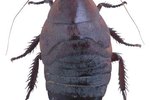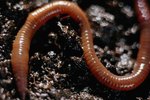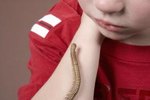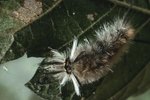
On the balance, centipedes are beneficial creatures that provide a great service to humans by consuming a number of roaches and other pests. However, caution is warranted as centipedes can give a mildly venomous sting via their first set of highly modified legs. Be sure that you don't confuse centipedes with centipede lookalikes.
Earwigs
Earwigs are small insects that are sometimes confused with scorpions. Their most identifiable trait is the pincer located at the rear of their body. Scientists refer to these pincers as cerci; in many insect lineages, cerci perform a sensory function. Various earwig species use these cerci differently; some use them to deter predators or defend their territory, while others use them to fold their wings after flight. While the pincers may give a human a very slight pinch, these insects are harmless to humans and even beneficial as they eat many insect pest species. Earwigs are unique in that they are one of the very few insect lineages that provide maternal care; mothers of some species tend to their eggs over the course of the winter until they hatch in the spring.
Silverfish
At a glance, silverfish are easy to confuse with centipedes. These small insects move very quickly and are nocturnal like centipedes. Though they only have six legs, they have long, prominent antennae, rearward-facing projections termed cerci and the terminal filament, which can appear like the long legs of house centipedes. Silverfish are scavengers with chewing mouthparts; they consume things like flour, grains, dried proteins, book covers and glue.
Millipedes
Millipedes are not insects, but invertebrates that belong to the order Diplopoda. Millipedes are distantly related to centipedes and look somewhat similar to them, but they have very different lifestyles. While centipedes have two legs per body segment, millipedes have four legs per segment. In addition, millipedes may curl into a defensive coil when frightened, whereas centipedes attempt to flee or bite in defense. In contrast to the predatory centipedes, millipedes are scavengers that primarily eat plant material.
Pill Bugs and Sow Bugs
Pill bugs, or roly polies as they are commonly called, are sometimes confused with centipedes. They require high moisture to survive, so you are most likely to see them under debris rather than out in the open. Pill bugs and their non-curling relatives, the sow bugs, are completely harmless. Both are scavengers that consume dead plant material. Roly polies are quite gregarious, and often more than one are found at a time.
References
- Oxford University Press: What Are Those Terrifying Centipede-Like Things?
- Colorado State University Extension: Millipedes, Centipedes and Sowbugs
- Texas A&M Agrilife Extension: Silverfish
- University of Minnesota: Cerci and Terminal Filament
- University of Rhode Island: Earwigs
- Amateur Entomologists' Society: Earwigs (Order: Dermaptera)
- Cooks Pest Control: Pill Bugs and Sow Bugs
Resources
Photo Credits
-
Brand X Pictures/Brand X Pictures/Getty Images




